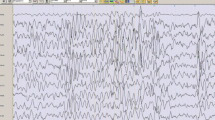Abstract
Objective
To identify the factors influencing brain injury in infants with congenital heart disease (CHD) after cardiac surgery.
Methods
This retrospective study investigated 103 infants with CHD undergoing cardiac surgery between January 2013 and February 2016. Pre- and postoperative amplitude-integrated electroencephalography (aEEG) recordings were assessed for background pattern, sleep-wake cycle pattern and seizure activity. Logistic regression model was used to determine the influencing factors of brain injury.
Results
Pre-operatively, most infants in our study exhibited a normal background pattern, with 16.5% showing discontinuous normal voltage, whereas this pattern was observed in only 7.8% of infants postoperatively. The improvement in background pattern after surgery was significant (P<0.05) in infants at no more than 39 weeks of gestational age. Infants with postoperative sepsis or severe postoperative infection were prone to show a worse sleep-wake cycle pattern after heart surgery.
Conclusion
The improvement in brain function of infants with CHD after cardiac surgery was associated with the gestational age and postoperative infection.
Similar content being viewed by others
References
van der Linde D, Konings EEM, Slager MA, Witsenburg M, Helbing WA, Takkenberg JJM, et al. Birth prevalence of congenital heart disease worldwide a systematic review and meta-analysis. J Am Coll Cardiol. 2011;58:2241–7.
Claessens NHP, Algra SO, Ouwehand TL, Jansen NJG, Schappin R, Haas F, et al. Perioperative neonatal brain injury is associated with worse school-age neurodevelopment in children with critical congenital heart disease. Dev Med Child Neurol. 2018;60:1052–8.
Marino BS, Lipkin PH, Newburger JW, Peacock G, Gerdes M, Gaynor JW, et al. Neurodevelopmental outcomes in children with congenital heart disease: Evaluation and management a scientific statement from the American Heart Association. Circulation. 2012;126:1143–72.
Gaynor JW, Stopp C, Wypij D, Andropoulos DB, Atallah J, Atz AM, et al. Neurodevelopmental outcomes after cardiac surgery in infancy. Pediatrics. 2015;135:816–25.
Claessens NHP, Noorlag L, Weeke LC, Toet MC, Breur JMPJ, Algra SO, et al. Amplitude-integrated electroencephalography for early recognition of brain injury in neonates with critical congenital heart disease. J Pediatr. 2018;202:199–205.
Dimitropoulos A, McQuillen PS, Sethi V, Moosa A, Chau V, Xu D, et al. Brain injury and development in newborns with critical congenital heart disease. Neurology. 2013;81:241–8.
Peyvandi S, De Santiago V, Chakkarapani E, Chau V, Campbell A, Poskitt KJ, et al. Association of prenatal diagnosis of critical congenital heart disease with postnatal brain development and the risk of brain injury. JAMA Pediatr. 2016;170.
al Naqeeb N, Edwards AD, Cowan FM, Azzopardi D. Assessment of neonatal encephalopathy by amplitude-integrated electroencephalography. Pediatrics. 1999;103:1263–71.
Zhang L, Zhou YX, Li XF, Cheng TT. Hyperbilirubinemia influences sleep-wake cycles of term newborns in a nonlinear manner. PloS One. 2017;12.
Shah NA, Wusthoff CJ. How to use: amplitude-integrated EEG (aEEG). Arch Dis Child Educ Pract Ed. 2015;100:75–81.
Gunn JK, Beca J, Penny DJ, Horton SB, d’Udekem YA, Brizard CP, et al. Amplitude-integrated electroencephalography and brain injury in infants undergoing norwood-type operations. Ann Thorac Surg. 2012;93:170–6.
Toet MC, Flinterman A, van de Laar I, de Vries JW, Bennink GBWE, Uiterwaal CSPM, et al. Cerebral oxygen saturation and electrical brain activity before, during, and up to 36 hours after arterial switch procedure in neonates without pre-existing brain damage: Its relationship to neurodevelopmental outcome. Exp Brain Res. 2005;165:343–50.
Latal B, Wohlrab G, Brotschi B, Beck I, Knirsch W, Bernet V. Postoperative amplitude-integrated electroencephalography predicts four-year neurodevelopmental outcome in children with complex congenital heart disease. J Pediatr. 2016;178:55–60.
Gunn JK, Beca J, Hunt RW, Olischar M, Shekerdemian LS. Perioperative amplitude-integrated EEG and neurodevelopment in infants with congenital heart disease. Intensive Care Med. 2012;38:1539–47.
Algra SO, Schouten AN, Jansen NJ, van Oeveren W, Haas F, Groenendaal F, et al. Perioperative and bedside cerebral monitoring identifies cerebral injury after surgical correction of congenital aortic arch obstruction. Intensive Care Med. 2015;41:2011–2.
Petit CJ, Rome JJ, Wernovsky G, Mason SE, Shera DM, Nicolson SC, et al. Preoperative Brain Injury in Transposition of the Great Arteries Is Associated With Oxygenation and Time to Surgery, Not Balloon Atrial Septostomy. Circulation. 2009;119:709–16.
Beca J, Gunn JK, Coleman L, Hope A, Reed PW, Hunt RW, et al. New white matter brain injury after infant heart surgery is associated with diagnostic group and the use of circulatory arrest. Circulation. 2013;127:971–9.
McQuillen PS, Barkovich AJ, Hamrick SEG, Perez M, Ward P, Glidden DV, et al. Temporal and anatomic risk profile of brain injury with neonatal repair of congenital heart defects. Stroke. 2007;38:736–41.
Funding
This work was supported by the National Key Research and Development Plan Project (2018YFC1002600).
Author information
Authors and Affiliations
Contributions
JG: study design and manuscript preparation; SRH, JZ, JMC: guarantor of integrity of the entire study; YXS: study concepts; YML,SXL: clinical studies; CC: statistical analysis; YR: data acquisition; BW: data analysis. All authors are approved to this manuscript.
Corresponding author
Additional information
Competing Interest
None stated.
Rights and permissions
About this article
Cite this article
Gui, J., He, S., Zhuang, J. et al. Peri- and Post-operative Amplitude-integrated Electroencephalography in Infants with Congenital Heart Disease. Indian Pediatr 57, 133–137 (2020). https://doi.org/10.1007/s13312-020-1730-0
Received:
Revised:
Accepted:
Published:
Issue Date:
DOI: https://doi.org/10.1007/s13312-020-1730-0




